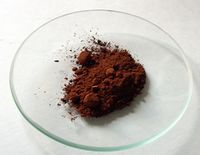Cadmium oxide
 Beta form of cadmium oxide
| |
| Names | |
|---|---|
| IUPAC name
Cadmium oxide
| |
| Other names
Cadmium fume
Cadmium monoxide Cadmium(II) oxide | |
| Identifiers | |
| Jmol-3D images | Image |
| |
| Properties | |
| CdO | |
| Molar mass | 128.413 g/mol |
| Appearance | Colorless, amourphous solid (alpha form), brown-red crystals (beta form) |
| Odor | Odorless |
| Density | 6.95 g/cm3 (amorphous), 8.15 g/cm3 (crystalline) |
| Melting point | 900–1,000 °C (1,650–1,830 °F; 1,170–1,270 K) (decomposition of amorphous form) |
| Boiling point | 1,559 °C (2,838 °F; 1,832 K) (sublimation) |
| 0.48 mg/100 ml | |
| Solubility | Reacts with acids Slowly soluble in ammonium salts Insoluble in alkalis, organic solvents |
| Vapor pressure | 0.13 kPa (1000 °C) 2.62 kPa (1200 °C) 61.4 kPa (1500 °C) |
| Thermochemistry | |
| Std molar
entropy (S |
55 J·mol-1·K-1 |
| Std enthalpy of
formation (ΔfH |
−258 kJ/mol |
| Hazards | |
| Safety data sheet | Sigma-Aldrich |
| Flash point | Non-flammable |
| Lethal dose or concentration (LD, LC): | |
| LD50 (Median dose)
|
72 mg/kg (rat, oral) 72 mg/kg (mouse, oral) |
| Related compounds | |
| Related compounds
|
Zinc oxide Mercury(II) oxide |
| Except where otherwise noted, data are given for materials in their standard state (at 25 °C [77 °F], 100 kPa). | |
| Infobox references | |
Cadmium oxide (CdO) is the extremely toxic oxide of cadmium.
Contents
Properties
Chemical
CdO is a basic oxide and is thus attacked by aqueous acids to give solutions of [Cd(H2O)6]2+. Upon treatment with strong alkaline solutions, [Cd(OH)
4]2−
forms.[1]
Physical
Cadmium oxide appears as brown crystals or brown amorphous powder. It is practically insoluble in water as well as organic solvents and readily reacts with acids and bases.
Availability
Cadmium oxide can be bought from some chemical suppliers, though the compound may not available for the private individual in many countries.
Preparation
Cadmium oxide can be made by oxidizing cadmium metal in air or oxygen.
Can also be obtained by calcinating cadmium hydroxide, which can be obtained by precipitating cadmium salts with an equivalent amount of sodium hydroxide.
Projects
- Make cadmium salts
- Compound collecting
- Make transparent conductive materials
- Cadmium plating
- Pigment
Handling
Safety
Cadmium compounds are extremely toxic and carcinogenic. Avoid making dust or aerosols when handling the compound, wear thick gloves, and work in a fume hood.
Storage
Store in clearly labeled, closed containers, preferably made of plastic, as the container will not break if dropped on the floor.
Disposal
Might be accepted by hazardous waste facilities that accept old batteries due to cadmium's past use in batteries.
References
Relevant Sciencemadness threads
- Chemical pages without CAS Registry Number
- Articles without EBI source
- Chemical pages without ChemSpiderID
- Chemical pages without DrugBank identifier
- Articles without KEGG source
- Articles without InChI source
- Articles without UNII source
- Articles containing unverified chemical infoboxes
- Chemical compounds
- Inorganic compounds
- Cadmium compounds
- Oxides
- Materials unstable in acidic solution
- Pigments
- Carcinogenic